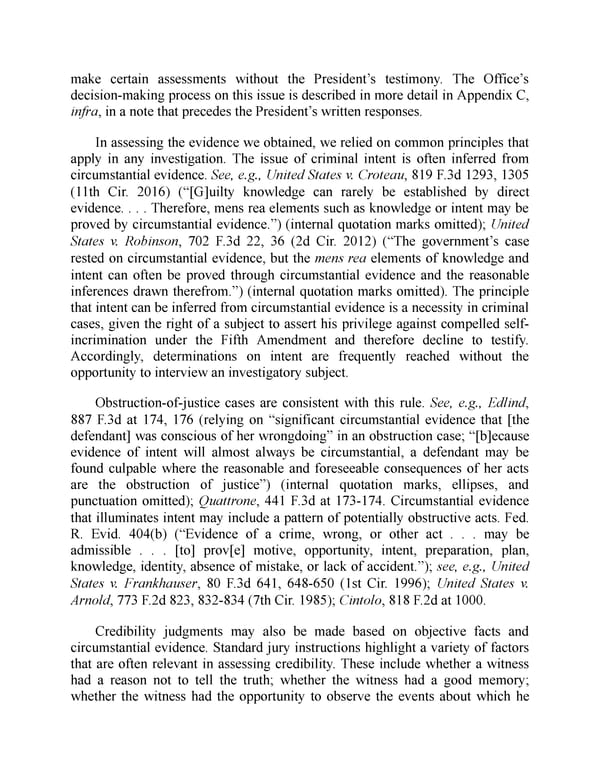make certain assessments without the President’s testimony. The Office’s decision-making process on this issue is described in more detail in Appendix C, infra, in a note that precedes the President’s written responses. In assessing the evidence we obtained, we relied on common principles that apply in any investigation. The issue of criminal intent is often inferred from circumstantial evidence. See, e.g., United States v. Croteau, 819 F.3d 1293, 1305 (11th Cir. 2016) (“[G]uilty knowledge can rarely be established by direct evidence. . . . Therefore, mens rea elements such as knowledge or intent may be proved by circumstantial evidence.”) (internal quotation marks omitted); United States v. Robinson, 702 F.3d 22, 36 (2d Cir. 2012) (“The government’s case rested on circumstantial evidence, but the mens rea elements of knowledge and intent can often be proved through circumstantial evidence and the reasonable inferences drawn therefrom.”) (internal quotation marks omitted). The principle that intent can be inferred from circumstantial evidence is a necessity in criminal cases, given the right of a subject to assert his privilege against compelled self- incrimination under the Fifth Amendment and therefore decline to testify. Accordingly, determinations on intent are frequently reached without the opportunity to interview an investigatory subject. Obstruction-of-justice cases are consistent with this rule. See, e.g., Edlind, 887 F.3d at 174, 176 (relying on “significant circumstantial evidence that [the defendant] was conscious of her wrongdoing” in an obstruction case; “[b]ecause evidence of intent will almost always be circumstantial, a defendant may be found culpable where the reasonable and foreseeable consequences of her acts are the obstruction of justice”) (internal quotation marks, ellipses, and punctuation omitted); Quattrone, 441 F.3d at 173-174. Circumstantial evidence that illuminates intent may include a pattern of potentially obstructive acts. Fed. R. Evid. 404(b) (“Evidence of a crime, wrong, or other act . . . may be admissible . . . [to] prov[e] motive, opportunity, intent, preparation, plan, knowledge, identity, absence of mistake, or lack of accident.”); see, e.g., United States v. Frankhauser, 80 F.3d 641, 648-650 (1st Cir. 1996); United States v. Arnold, 773 F.2d 823, 832-834 (7th Cir. 1985); Cintolo, 818 F.2d at 1000. Credibility judgments may also be made based on objective facts and circumstantial evidence. Standard jury instructions highlight a variety of factors that are often relevant in assessing credibility. These include whether a witness had a reason not to tell the truth; whether the witness had a good memory; whether the witness had the opportunity to observe the events about which he
 Mueller Report PDF Page 290 Page 292
Mueller Report PDF Page 290 Page 292